
On this year of 2022, the eldest of Generation Z (or Gen Z, or Zoomers) is 26 while the youngest is 12, yet the group’s dominance is already being felt.
In 2019, they became the largest generation, constituting 32 percent of the global population – or 2.47 billion of the 7.7 billion people on Earth – surpassing the Millennials and Baby Boomers, respectively. [1]
Yet information on how to design for the younger of this generation is sparse at best, specially when dealing with teenagers (14 – 18 years old). I recently was tasked with a project aimed at this younger demographic and had some research done. These are my findings.
Tone of voice when talking to teens
Teens spend a lot of their free time online (74%) and are more used to mobile devices than desktops or laptops. Despite this, they aren’t as tech savvy as Millennials (born between 1980 and 1996) and have insufficient reading skills [2]. This doesn’t mean they don’t read, rather they’re more likely to skim key points and skip long text blocks altogether as they are impatient users.
Illustrating concepts visually is key.
While using childish visuals to represent an idea is seen as condescending, they still prefer to visualise information as neutral graphics and using age-appropriate language. “Age-appropriate” though does not mean “talking down” to them or using their slang – teens actually respond badly to companies who attempt to use their language; rather using neutral adult language without being condescending or using acronyms and business terms.

As for mistakes (such as error messages), teens tend to blame the service rather than themselves. If something goes wrong, they’ll blame bad UX.
Also, don’t call them “kids”.
How teens use the net
As mentioned, teens spend a lot of time online. While online, teens are very goal-oriented. They don’t use the web aimlessly; even social media usage (TikTok has 60% of the user base being Gen Z [3]) has as a main goal to entertain and even inform.
They also rely heavily on search – not just on search engines but internal search systems. Despite this, they have difficulty formulating search queries preferring to use natural language (as opposed to verbatim search).
As an example, when searching for fox noises, instead of using the query:
Animal fox sound example
Zoomers will use the following query:
What does a fox sound like?
Scrolling is not an issue and is done absent-mindedly, and while subtle animation and sound effects are enjoyed sparsely, music autoplay is not (then again, this hasn’t been enjoyed by most even during it’s height in the early 00’s) [2].
Loading time is also a factor; teens are impatient and don’t like waiting [4]. They also hate popups, but once again this is a universal sentiment.
While Gen Z is highly sociable online (85% of them use social media to keep up with current affairs) [5], they are also very concerned about their privacy [2]; just because something could be shared online, doesn’t mean they will. And when it’s a viable and acceptable option, teens still prefer to have the option of where to share – sometimes they’ll rather share it individually (like via iMessage or Whatsapp) instead of publicly (like on Instagram) [2].
Talking about social media, Snapchat, Instagram, TikTok and YouTube are the most used ones, while Facebook and Twitter have seen a steady decline over the last few years [7].

And when talking about judging credibility on social media, teens fare worst than other age groups, choosing to believe what similar peers publish without doing additional research on their own [8]. This leads to widespread false information dissemination [9].
Teens aren’t the future – they are the present
Elder Gen Z are already in the workplace and teenagers are slowly making their way into it too, therefore they don’t want to be treated as children. Gen Z are highly aspirational, don’t believe college is the only path to a strong education [10], and statistics about the Zoomers show that by 2026, this age group will account for 82 million of all US consumers [11].

And despite all this information, more research should be conducted specifically within UX to better understand the needs and wants of the current generation of teens and how we can build better products for them.
Authors note: I am very conscious that this article does not represent something a teen might usually read due to it’s clear lack of visual concepts and concise and short paragraphs. In my defence, I know who my audience is.
References
- [1] – Generation Z is bigger than millennials – and they’re out to change the world
- [2] – Teenager’s UX: Designing for Teens
- [3] – 50 Stats All Marketers Must Know About Gen-Z
- [4] – What do Gen Z shoppers really want? (PDF)
- [5] – Gen Z: Born to Be Digital
- [6] – Marketing Charts (IMG)
- [7] – Social Media Use in 2021
- [8] – Generation Z: 10 Stats From SXSW You Need To Know
- [9] – Understanding Generation Z on Social Media (As Told By a Zillennial)
- [10] – Gen Z: What To Expect From The New Workforce
- [11] – Generation Z News: Latest characteristics, research, and facts
- Featured image: Parker Gibbons (via Unsplash)